Bruno Sokal
A Decoupled Channel Estimation Method for Beyond Diagonal RIS
Dec 09, 2024Abstract:Beyond diagonal reconfigurable intelligent surface (BD-RIS) is a new architecture for RIS where elements are interconnected to provide more wave manipulation flexibility than traditional single connected RIS, enhancing data rate and coverage. However, channel estimation for BD-RIS is challenging due to the more complex multiple-connection structure involving their scattering elements. To address this issue, this paper proposes a decoupled channel estimation method for BD-RIS that yields separate estimates of the involved channels to enhance the accuracy of the overall combined channel by capitalizing on its Kronecker structure. Starting from a least squares estimate of the combined channel and by properly reshaping the resulting filtered signal, the proposed algorithm resorts to a Khatri-Rao Factorization (KRF) method that teases out the individual channels based on simple rank-one matrix approximation steps. Numerical results show that the proposed decoupled channel estimation yields more accurate channel estimates than the classical least squares scheme.
RIS-Assisted Sensing: A Nested Tensor Decomposition-Based Approach
Dec 03, 2024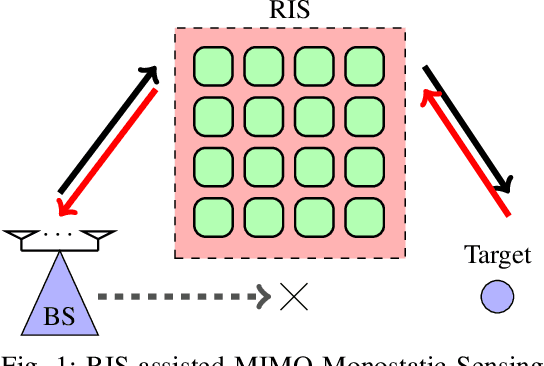

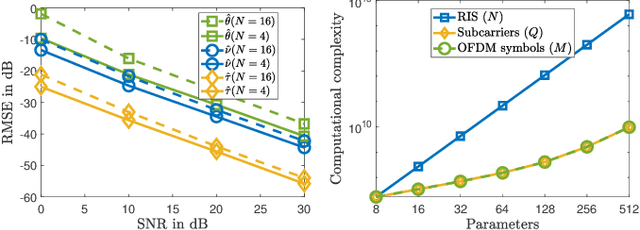
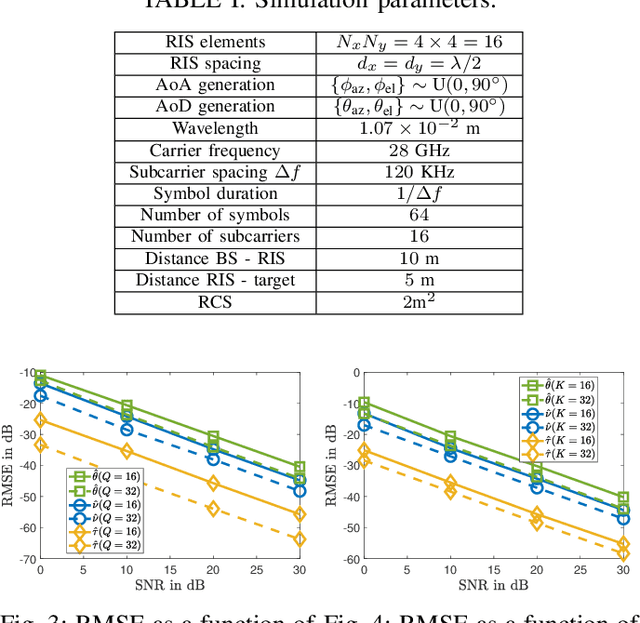
Abstract:We study a monostatic multiple-input multiple-output sensing scenario assisted by a reconfigurable intelligent surface using tensor signal modeling. We propose a method that exploits the intrinsic multidimensional structure of the received echo signal, allowing us to recast the target sensing problem as a nested tensor-based decomposition problem to jointly estimate the delay, Doppler, and angular information of the target. We derive a two-stage approach based on the alternating least squares algorithm followed by the estimation of the signal parameters via rotational invariance techniques to extract the target parameters. Simulation results show that the proposed tensor-based algorithm yields accurate estimates of the sensing parameters with low complexity.
Channel Estimation for Beyond Diagonal RIS via Tensor Decomposition
Jul 29, 2024Abstract:This paper addresses the channel estimation problem for beyond diagonal reconfigurable intelligent surface (BD-RIS) from a tensor decomposition perspective. We first show that the received pilot signals can be arranged as a three-way tensor, allowing us to recast the cascaded channel estimation problem as a block Tucker decomposition problem that yields decoupled estimates for the involved channel matrices while offering a substantial performance gain over the conventional (matrix-based) least squares (LS) estimation method. More specifically, we develop two solutions to solve the problem. The first one is a closed-form solution that extracts the channel estimates via a block Tucker Kronecker factorization (BTKF), which boils down to solving a set of parallel rank-one matrix approximation problems. Exploiting such a low-rank property yields a noise rejection gain compared to the standard LS estimation scheme while allowing the two involved channels to be estimated separately. The second solution is based on a block Tucker alternating least squares (BTALS) algorithm that directly estimates the involved channel matrices using an iterative estimation procedure. We discuss the uniqueness and identifiability issues and their implications for training design. We also propose a tensor-based design of the BD-RIS training tensor for each algorithm that ensures unique decoupled channel estimates under trivial scaling ambiguities. Our numerical results shed light on the tradeoffs offered by BTKF and BTALS methods. Specifically, while the first enjoys fast and parallel extraction of the channel estimates in closed form, the second has a more flexible training design, allowing for a significantly reduced training overhead compared to the state-of-the-art LS method.
Tensor-based modeling/estimation of static channels in IRS-assisted MIMO systems
Jun 21, 2023Abstract:This paper proposes a tensor-based parametric modeling and estimation framework in multiple-input multiple-output (MIMO) systems assisted by intelligent reflecting surfaces (IRSs). We present two algorithms that exploit the tensor structure of the received pilot signal to estimate the concatenated channel. The first one is an iterative solution based on the alternating least squares algorithm. In contrast, the second method provides closed-form estimates of the involved parameters using the high order single value decomposition. Our numerical results show that our proposed tensor-based methods provide improved performance compared to competing state-of-the-art channel estimation schemes, thanks to the exploitation of the algebraic tensor structure of the combined channel without additional computational complexity.
Tensor-Based Channel Estimation and Data-Aided Tracking in IRS-Assisted MIMO Systems
May 17, 2023



Abstract:This letter proposes a model for symbol detection in the uplink of IRS-assisted networks in the presence of channel aging. During the first stage, we model the received pilot signal as a tensor, which serves as a basis for both estimating the channel and configuring the IRS. In the second stage, the proposed tensor approach tracks the aging process to detect and estimate the transmitted data symbols. Our evaluations show that our proposed channel and symbol estimation schemes improve the performance of IRS-assisted systems in terms of the achieved bit error rate and mean squared error of the received data, compared to state of the art schemes.
Two-Dimensional Channel Parameter Estimation for IRS-Assisted Networks
May 07, 2023

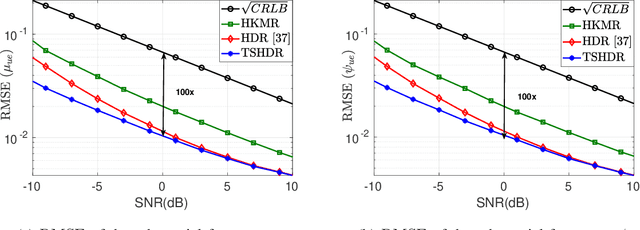
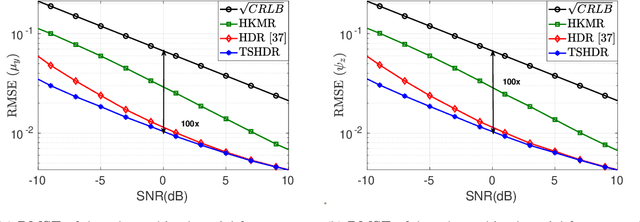
Abstract:This paper proposes a pilot decoupling-based two-dimensional channel parameter estimation method for intelligent reflecting surface (IRS)-assisted networks. We exploit the combined effect of Terahertz sparse propagation and the geometrical structure of arrays deployed at the base station, the IRS, and the user equipment to develop a low-complexity channel parameter estimation method. By means of a new pilot design along the horizontal and vertical domains, the overall channel parameter estimation problem is decoupled into different domains. Furthermore, with this decoupling, it is possible to simultaneously sense/estimate the channel parameters and to communicate with the sensed node. Specifically, we derive two estimators by decoupling the global problem into sub-problems and exploiting the built-in tensor structure of the sensing/estimation problem by means of multiple rank-one approximations. The Cram\'er-Rao lower bound is derived to assess the performance of the proposed estimators. We show that the two proposed methods yield accurate parameter estimates and outperform state-of-the-art methods in terms of complexity. The tradeoffs between performance and complexity offered by the proposed methods are discussed and numerically assessed.
Tensor-Based High-Resolution Channel Estimation for RIS-Assisted Communications
Apr 12, 2023



Abstract:This letter proposes a high-resolution channel estimation for reconfigurable intelligent surface (RIS)-assisted communication networks. We exploit the inherent geometrical structure of the Terahertz propagation channel, including the antenna array geometries at the base station, the RIS, and the user equipment to design a tensor-based high-resolution channel estimator, referred to as the higher-dimensional rank-one approximations (HDR) method. By exploiting the geometrical structure of the combined base station-RIS-user equipment channel, the proposed HDR estimator recasts parametric channel estimation as a single sixth-order rank-one tensor approximation problem, which can be efficiently solved using higher-order singular value decomposition to deliver parallel estimates of each channel component vector. Numerical results show that the proposed method provides significantly more accurate parameter estimates compared to the competing state-of-the-art Khatri-Rao factorization and least squares methods. The HDR method also leads to higher spectral efficiency than its competitors, especially in the low signal-to-noise ratio regime, while having similar computational complexity as the classical least squares method.
Channel Estimation in RIS-Assisted MIMO Systems Operating Under Imperfections
Jul 06, 2022



Abstract:Reconfigurable intelligent surface is a potential technology component of future wireless networks due to its capability of shaping the wireless environment. The promising MIMO systems in terms of extended coverage and enhanced capacity are, however, critically dependent on the accuracy of the channel state information. However, traditional channel estimation schemes are not applicable in RIS-assisted MIMO networks, since passive RISs typically lack the signal processing capabilities that are assumed by channel estimation algorithms. This becomes most problematic when physical imperfections or electronic impairments affect the RIS due to its exposition to different environmental effects or caused by hardware limitations from the circuitry. While these real-world effects are typically ignored in the literature, in this paper we propose efficient channel estimation schemes for RIS-assisted MIMO systems taking different imperfections into account. Specifically, we propose two sets of tensor-based algorithms, based on the parallel factor analysis decomposition schemes. First, by assuming a long-term model in which the RIS imperfections, modeled as unknown phase shifts, are static within the channel coherence time we formulate an iterative alternating least squares (ALS)-based algorithm for the joint estimation of the communication channels and the unknown phase deviations. Next, we develop the short-term imperfection model, which allows both amplitude and phase RIS imperfections to be non-static with respect to the channel coherence time. We propose two iterative ALS-based and closed-form higher order singular value decomposition-based algorithms for the joint estimation of the channels and the unknown impairments. Moreover, we analyze the identifiability and computational complexity of the proposed algorithms and study the effects of various imperfections on the channel estimation quality.
Reducing the Control Overhead of Intelligent Reconfigurable Surfaces Via a Tensor-Based Low-Rank Factorization Approach
Jun 10, 2022
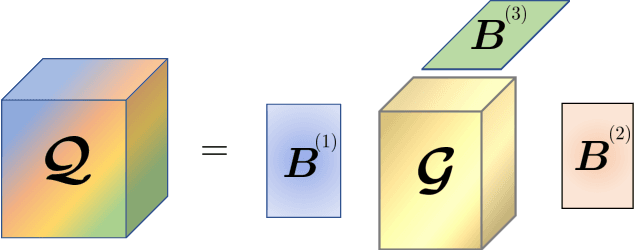

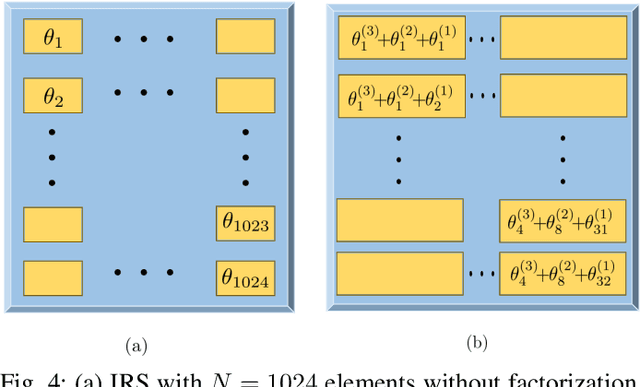
Abstract:Passive intelligent reconfigurable surfaces (IRS) are becoming an attractive component of cellular networks due to their ability of shaping the propagation environment and thereby improving the coverage. While passive IRS nodes incorporate a great number of phase-shifting elements and a controller entity, the phase-shifts are typically determined by the cellular base station (BS) due to its computational capability. Since the fine granularity control of the large number of phase-shifters may become prohibitive in practice, it is important to reduce the control overhead between the BS and the IRS controller. To this end, in this paper we propose a low-rank approximation of the near-optimal phase-shifts, which would incur prohibitively high communication overhead on the BS-IRS controller links. The key idea is to represent the potentially large IRS phase-shift vector using a low-rank tensor model. This is achieved by factorizing a tensorized version of the IRS phase-shift vector, where each component is modeled as the Kronecker product of a predefined number of factors of smaller sizes, which can be obtained via tensor decomposition algorithms. We show that the proposed low-rank models drastically reduce the required feedback requirements associated with the BS-IRS control links. Our simulation results indicate that the proposed method is especially attractive in scenarios with a strong line of sight component, in which case nearly the same spectral efficiency is reached as in the cases with near-optimal phase-shifts, but with a drastically reduced communication overhead.
Tensor-Based Channel Estimation for RIS-Assisted Networks Operating Under Imperfections
Jun 07, 2022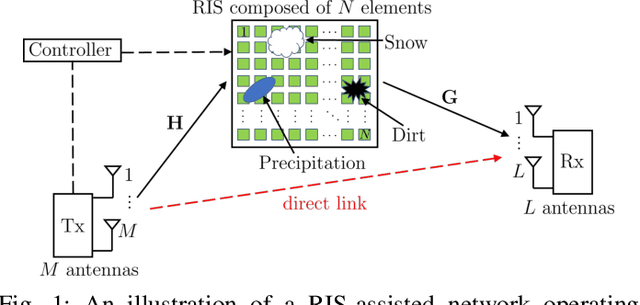
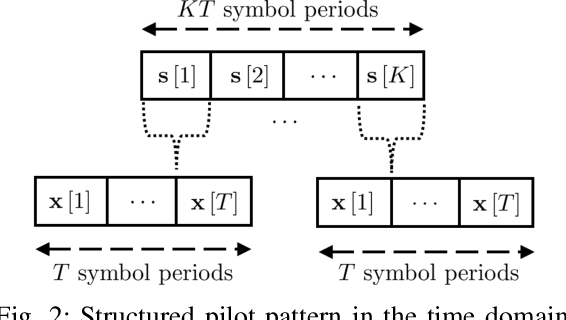

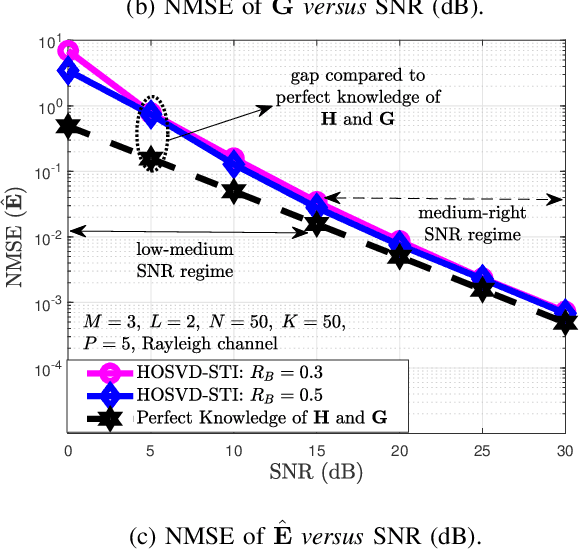
Abstract:Reconfigurable intelligent surface (RIS) is a candidate technology for future wireless networks. It enables to shape the wireless environment to reach massive connectivity and enhanced data rate. The promising gains of RIS-assisted networks are, however, strongly depends on the accuracy of the channel state information. Due to the passive nature of the RIS elements, channel estimation may become challenging. This becomes most evident when physical imperfections or electronic impairments affect the RIS due to its exposition to different environmental effects or caused by hardware limitations from the circuitry. In this paper, we propose an efficient and low-complexity tensor-based channel estimation approach in RIS-assisted networks taking different imperfections into account. By assuming a short-term model in which the RIS imperfections behavior, modeled as unknown amplitude and phase shifts deviations, is non-static with respect to the channel coherence time, we formulate a closed-form higher order singular value decomposition based algorithm for the joint estimation of the involved channels and the unknown impairments. Furthermore, the identifiability and computational complexity of the proposed algorithm are analyzed, and we study the effect of different imperfections on the channel estimation quality. Simulation results demonstrate the effectiveness of our proposed tensor-based algorithm in terms of the estimation accuracy and computational complexity compared to competing tensor-based iterative alternating solutions.
 Add to Chrome
Add to Chrome Add to Firefox
Add to Firefox Add to Edge
Add to Edge